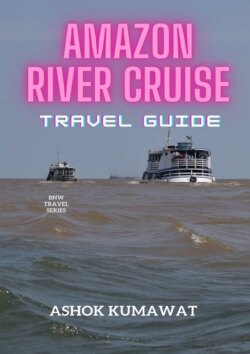Читать книгу Amazon River Cruise Travel Guide - Ashok Kumawat - Страница 9
На сайте Литреса книга снята с продажи.
Chapter 7: Best Time to Visit the Amazon River
ОглавлениеChoosing the perfect time to embark on your Amazon River cruise is crucial for a rewarding and memorable experience. The Amazon Rainforest experiences distinct seasons, each offering unique advantages and opportunities for wildlife sightings, weather conditions, and overall travel experiences. In this chapter, we explore the different seasons of the Amazon and guide you in selecting the best time to visit the Amazon River based on your preferences and interests.
The Wet Season (December to May):
The wet season, also known as the «high-water season,» occurs from December to May. During this time, the Amazon River and its tributaries swell, flooding the surrounding forests and creating a vast and interconnected waterway. The wet season brings a range of advantages and considerations for travelers:
Lush Greenery: The rainforest is in full bloom during the wet season, with vegetation reaching its peak vibrancy and abundance. The forest is a lush, emerald green, making it a breathtaking sight for nature lovers and photographers.
Aquatic Adventures: The high water levels open up opportunities for unique aquatic adventures, such as canoeing or kayaking through flooded forests and exploring hidden channels that are inaccessible during the dry season.
Wildlife Sightings: Although wildlife may be more dispersed during the wet season due to the abundance of water and resources, this time provides excellent opportunities for birdwatching and spotting aquatic species, such as pink river dolphins and caimans.
Fewer Crowds: The wet season tends to be less busy with fewer tourists compared to the dry season, allowing for a more tranquil and intimate experience with nature.
Rainfall and Humidity: Be prepared for frequent rain showers and high humidity during the wet season. Pack lightweight rain gear and clothing suitable for warm and damp conditions.
The Dry Season (June to November):
The dry season, also known as the «low-water season,» occurs from June to November. This period is characterized by lower water levels in the Amazon River and its tributaries. The dry season offers its own set of advantages and considerations for travelers:
Wildlife Concentration: As water sources shrink, wildlife becomes concentrated around the remaining waterholes, making it easier to spot and observe various animals, including jaguars, monkeys, and numerous bird species.
Beaches and Sandbanks: As the water recedes, sandy beaches and sandbanks emerge along the riverbanks. This provides unique opportunities for sunbathing, picnics, and wildlife sightings in these exposed areas.
Jungle Walks: The drier conditions make jungle walks and hiking more accessible, allowing for better exploration of rainforest trails and encounters with flora and fauna.
Comfortable Weather: The dry season offers more comfortable weather with cooler temperatures and lower humidity, providing a pleasant climate for outdoor activities.
Popular Time: The dry season is the most popular time to visit the Amazon River, and as a result, you can expect more tourists and potentially busier excursion sites.
Nighttime Observations: Clearer skies during the dry season provide opportunities for stargazing and observing nocturnal creatures, such as night monkeys and owls.
Overall Considerations for Your Visit:
Wildlife Goals: Consider your wildlife interests when selecting the best time to visit. If you are primarily interested in birdwatching, the wet season may offer a more diverse array of avian species. On the other hand, if your goal is to spot elusive mammals, the dry season may provide better opportunities for sightings.
Photography: Both seasons offer excellent photo opportunities, but the wet season may provide more vibrant greenery and the chance to capture unique shots of wildlife in flooded forests.
River Conditions: Water levels significantly impact the routes and accessibility of river cruises and excursions. Be sure to check with your cruise operator to understand how the seasons may affect your travel plans.
Local Festivals: Consider local festivals and events that take place during specific months, as they can add cultural richness and unique experiences to your Amazon River cruise.
Personal Preferences: Consider your tolerance for heat, humidity, and rain when choosing the best time to visit the Amazon River. Each season has its unique climate and conditions, and your comfort will greatly impact your enjoyment of the journey.
Conclusion:
Deciding when to embark on your Amazon River cruise is a crucial decision that will influence your overall experience in this unparalleled rainforest ecosystem. Whether you choose the wet season or the dry season, the Amazon River and its surrounding rainforest will mesmerize you with its biodiversity, wildlife encounters, and natural beauty. Keep in mind your wildlife interests, weather preferences, and travel goals to make an informed choice for a truly unforgettable and enriching Amazon River adventure.
